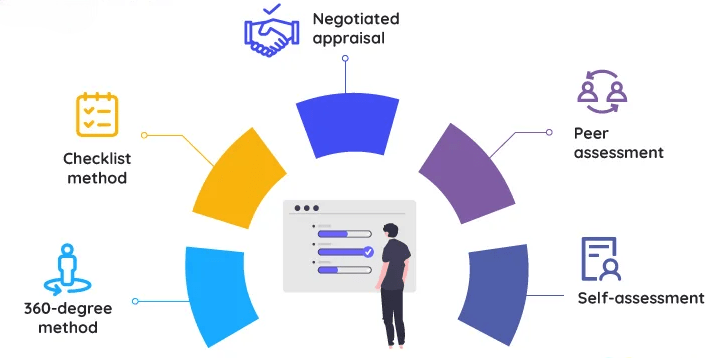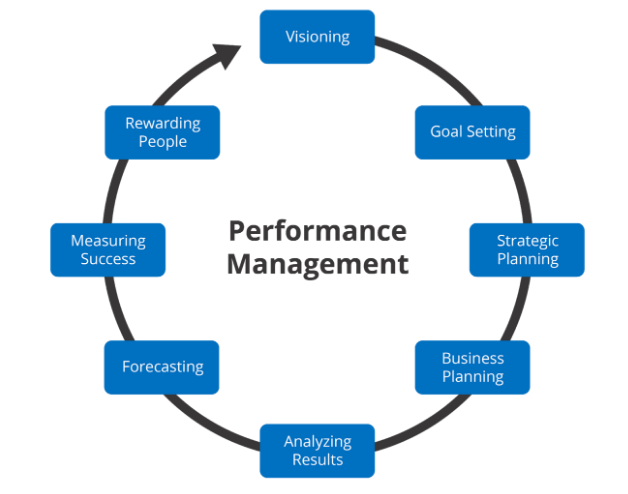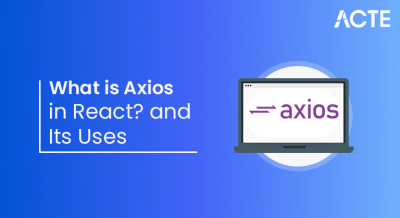
- Introduction to Performance Management
- What is Performance Appraisal?
- Key Differences between PM and PA
- Performance Management Process
- Types of Performance Appraisal Methods
- Tools and Techniques Used in PM and PA
- Benefits of Performance Management
- Conclusion
Introduction to Performance Management
Performance management is a dynamic and continuous process designed to enhance individual and organizational performance by aligning employee efforts with strategic goals. It extends far beyond the traditional concept of annual performance appraisals, emphasizing an ongoing cycle of goal-setting, monitoring, feedback, development, and evaluation. The primary objective of performance management is to ensure that employees are not only meeting their individual responsibilities but are also contributing effectively to the organization’s broader objectives. By setting clear and measurable goals, employees understand what is expected of them and can work purposefully toward achieving these targets. A strong performance management system promotes regular communication between managers and employees, allowing for timely feedback, recognition, and support. This ongoing dialogue helps identify strengths, uncover challenges, and provide opportunities for skill enhancement and career growth. As a result, employees feel more engaged and motivated, which boosts morale and job satisfaction. Furthermore, performance data collected throughout the cycle allows managers to make informed, data-driven decisions regarding promotions, training needs, and resource allocation. Crucially, performance management contributes to creating a culture of accountability and continuous improvement within an organization. When implemented effectively, it helps identify high-potential talent, address underperformance proactively, and align individual contributions with long-term business strategies. It also serves as a foundation for succession planning and leadership development. Ultimately, a well-structured performance management system not only drives productivity and profitability but also fosters a work environment where employees are encouraged to grow professionally, take ownership of their performance, and contribute meaningfully to organizational success.
What is Performance Appraisal?
Performance appraisal is a formal and structured process used to evaluate an employee’s job performance over a specific period, typically on an annual or semi-annual basis. It serves as a critical tool for assessing how well employees meet their job responsibilities and organizational expectations. Through this process, managers review various aspects of performance, including productivity, quality of work, communication skills, teamwork, and overall contribution to the organization. The evaluation often involves rating employees against pre-established goals or performance standards, offering a clear picture of their achievements, strengths, areas needing improvement, and growth potential. One of the primary purposes of performance appraisal is to provide employees with constructive feedback that can guide their professional development. Based on appraisal outcomes, decisions may be made regarding promotions, salary adjustments, bonuses, or further training and development opportunities. Performance appraisals also help in identifying high performers, addressing underperformance, and aligning individual goals with organizational objectives. Although performance appraisals are a key component of the broader performance management system, they differ in focus and approach. Performance appraisals are retrospective, concentrating on evaluating past behavior and outcomes, whereas performance management is a continuous and forward-looking process aimed at enhancing future performance.

While appraisals provide a snapshot of past performance, performance management involves ongoing communication, coaching, and support throughout the year. Together, both processes contribute to a comprehensive understanding of employee performance and help foster a culture of accountability, growth, and continuous improvement within the organization.
Key Differences between PM and PA
- Nature of Process: Performance Management is a continuous, ongoing process focused on improving employee performance throughout the year. Performance Appraisal, however, is a periodic, formal evaluation usually conducted annually or semi-annually.
- Purpose: PM aims to develop employees and align their goals with organizational objectives for long-term success. PA primarily assesses past performance to make decisions about promotions, rewards, or training needs.
- Focus: Performance Management is future-oriented, emphasizing goal-setting, coaching, and development. Performance Appraisal is retrospective, concentrating on evaluating what has already been accomplished.
- Scope: PM involves a broader range of activities including feedback, development, monitoring, and motivation. PA is a narrower process focused on reviewing and rating employee performance against set criteria.
- Feedback Frequency: In PM, feedback is frequent and informal, promoting real-time improvements. PA feedback tends to be formal and provided only during appraisal meetings.
- Participants: PM encourages two-way communication between managers and employees throughout the year. PA is often manager-driven, with limited employee input during the formal review.
- Outcome: Performance Management results in continuous improvement, employee development, and strategic alignment. Performance Appraisal leads to administrative decisions such as salary increments, promotions, or disciplinary actions.
- Goal Setting: The process begins with setting clear, measurable, and achievable goals aligned with organizational objectives. Employees and managers collaborate to define expectations and key performance indicators, ensuring clarity on what success looks like.
- Planning: After goals are set, a detailed plan is created outlining the tasks, resources, and timelines needed to achieve these objectives. This phase ensures that employees have a roadmap and the necessary support to meet their targets.
- Continuous Monitoring: Performance is tracked regularly throughout the review period. Managers and employees monitor progress, identify obstacles, and make adjustments as needed to stay on course.
- Ongoing Feedback and Coaching: Regular, constructive feedback is provided to employees to reinforce strengths and address areas needing improvement. Coaching helps employees develop skills and overcome challenges, fostering continuous growth.
- Development and Training: Based on feedback and performance insights, employees are offered development opportunities such as training, workshops, or mentoring. This supports skill enhancement and career progression.
- Performance Evaluation: At the end of the cycle, a formal review is conducted where employee performance is assessed against the pre-established goals and criteria. This evaluation is based on documented evidence and ongoing discussions.
- Recognition and Rewards: Outstanding performance is acknowledged through rewards such as promotions, bonuses, or public recognition. Constructive feedback is used to create development plans for further improvement where needed.
- 360-Degree Feedback: This technique gathers performance feedback from multiple sources, including peers, subordinates, supervisors, and sometimes customers.
- Rating Scales: Managers rate employees on various competencies like communication, teamwork, and job knowledge using predefined scales. This method provides quantitative data that is easy to compare and analyze.
- Management by Objectives (MBO): Employees and managers collaboratively set specific, measurable goals. Performance is then evaluated based on the achievement of these objectives, ensuring alignment with organizational priorities.
- Self-Assessment: Employees evaluate their own performance, promoting self-reflection and personal accountability. This self-evaluation is compared with managerial assessments to identify gaps and development needs.
- Behaviorally Anchored Rating Scales (BARS): This combines rating scales with specific behavioral examples, making assessments more objective and tied to actual job-related behaviors.
- Critical Incident Method: Managers document specific examples of effective or ineffective employee behavior throughout the review period. These incidents are used to provide detailed, behavior-focused feedback during appraisals.
- Performance Appraisal Software: Digital tools and platforms help streamline the performance management process by facilitating goal setting, continuous feedback, performance tracking, and documentation. They improve accuracy and ease communication between employees and managers.
Performance Management Process

Types of Performance Appraisal Methods
Performance appraisal methods vary in approach and effectiveness, each offering unique insights into employee performance. One widely used method is 360-degree feedback, which gathers input from multiple sources, including peers, subordinates, supervisors, and sometimes clients. This method offers a comprehensive and balanced view of an employee’s performance, capturing different perspectives and reducing individual bias. Another approach is self-assessment, where employees evaluate their own performance. This method promotes self-awareness, encourages reflection, and fosters a sense of ownership and accountability for personal development. Rating scales are another commonly used method, where managers assess employees on predefined criteria such as communication, teamwork, or technical skills. These are easy to use and generate quantitative data, but they may lack depth and be prone to subjectivity. A more detailed and behavior-focused method is the Behaviorally Anchored Rating Scale (BARS), which combines aspects of rating scales and the critical incident method. BARS uses specific behavioral examples linked to rating levels, making assessments more objective and consistent. Management by Objectives (MBO) emphasizes goal-setting and results. In this method, employees and managers collaboratively set clear, measurable objectives. Performance is then evaluated based on the achievement of these goals, promoting alignment with organizational priorities. Lastly, the critical incident method involves documenting specific instances of an employee’s effective or ineffective behaviors throughout the review period. This approach provides real examples to support evaluations but can be time-consuming and requires diligent record-keeping. Each method has its strengths and limitations, and organizations often use a combination to achieve a more accurate and holistic appraisal process.
Tools and Techniques Used in PM and PA
Benefits of Performance Management
Effective performance management offers several key benefits that contribute to both individual and organizational success. One of the most significant advantages is improved employee performance. Regular feedback, clear expectations, and continuous goal-setting help employees stay focused and motivated. When individuals understand what is expected of them and receive timely guidance, they are more likely to perform at their best and continuously seek improvement. Another major benefit is better alignment with organizational goals. Performance management ensures that each employee’s objectives are in sync with the broader goals of the company. This alignment creates a unified direction across departments and teams, allowing the organization to move forward cohesively and efficiently. Employees are more likely to see the relevance of their work when their efforts contribute directly to the company’s success. Employee development is also a key outcome of effective performance management. By identifying strengths and areas for improvement, managers can support employees in building their skills and advancing their careers. This not only prepares individuals for future roles within the organization but also helps in retaining talent by offering clear career progression paths. Finally, performance management leads to increased employee engagement. Employees who receive consistent feedback, understand their goals, and feel recognized for their contributions are more committed and satisfied in their roles. Engaged employees are more productive, show greater loyalty, and contribute positively to workplace culture. Overall, a robust performance management system is essential for fostering a high-performance environment that benefits both the organization and its workforce.
Conclusion
Performance management and performance appraisal play a vital role in cultivating a high-performance culture within any organization. Though closely related, these two processes serve distinct yet complementary purposes. Performance management is an ongoing process focused on enhancing employee effectiveness through continuous feedback, goal-setting, coaching, and development. It aims to create an environment where employees are consistently aligned with the organization’s strategic direction and are supported in achieving their personal and professional objectives. On the other hand, performance appraisal is a more formal, periodic evaluation of an employee’s past performance. It typically informs key decisions related to promotions, compensation, training needs, and career advancement. While performance appraisals provide a structured assessment, performance management ensures that employees receive the support and feedback needed to grow and improve between appraisal periods. When both processes are effectively integrated, organizations benefit from a more engaged and productive workforce. Employees have a clear understanding of what is expected of them and receive regular input on how to improve and succeed. This alignment between individual performance and organizational goals not only boosts productivity but also enhances employee morale and retention. Furthermore, the incorporation of modern tools and feedback mechanisms such as real-time performance tracking, 360-degree reviews, and development plans can make both processes more effective and data-driven. Ultimately, a well-balanced approach to performance management and appraisal empowers organizations to build a culture centered on continuous improvement, accountability, and shared success, leading to sustained growth and competitive advantage.



